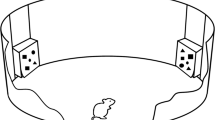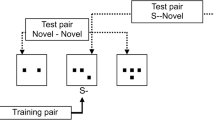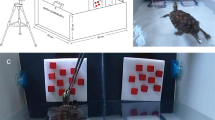Abstract
Numerical competence is one of the aspects of animal cognition with a long history of research interest, but few results are available for the horse. In the present study, we investigated the ability of three Shetland ponies to discriminate between different quantities of geometric symbols presented on a computer screen in a matching-to-sample arrangement. In Experiment 1, the ponies had to relate two similar quantities to another, paired in contrasts (1 vs. 2, 3 vs. 4 and 4 vs. 5) of the same stimulus (dot). Specific pairs of quantities (all differing by one) of up to five different geometrical symbols were displayed in Experiment 2. In each session, both quantities (more and less) were used as sample in such a way that each of the two quantities presented in one test served as positive and as negative stimulus, respectively. The three Shetland ponies were able to discriminate between the given quantities of dots by showing more than 80 % correct responses in two consecutive sessions. Only one of the ponies distinguished different shapes of geometric symbols at a level of 4 versus 5 items. The results show that all ponies were capable of visual quantity discrimination in the present matching-to-sample design, but task solving seemed more difficult when quantities were composed of heterogeneous stimuli. The present results confirm our hypothesis that the ponies based their decision on the matching concept of sameness and were not biased by a spontaneous preference for higher quantities.






Similar content being viewed by others
References
Agrillo C, Dadda M, Serena G, Biscazza A (2007) Quantity discrimination in female mosquitofish. Anim Cogn 10:63–70
Agrillo C, Dadda M, Serena G, Biscazza A (2008) Do fish count? Spontaneous discrimination of quantity in female mosquito fish. Anim Cogn 11:495–503
Agrillo C, Piffer L, Bisazza A, Butterworth B (2012) Evidence for two numerical systems that are similar in humans and guppies. PLoS One 7(2):e31923. doi:10.1371/journal.pone.0031923
Ahrendt LP, Christensen JW, Ladewig J (2012) The ability of horses to learn an instrumental task through social observation. Appl Anim Behav Sci 139:105–113
Allik J, Tuulmets T (1991) Occupancy model of perceived numerosity. Percept Psychophys 49(4):303–314
Anderson US, Stoinski TS, Bloomsmith MA, Marr MJ, Smith AD, Maple TL (2005) Relative numerousness judgment and summation in young and old Western lowland gorillas. J Comp Psychol 119:285–295
Asano T, Kojima T, Matsuzawa T, Kubota K, Murofushi K (1982) Object and color naming in chimpanzees (Pan troglodytes). Proc Jpn Acad Ser B 58:118–122
Baker AEM, Crawford BH (1986) Observational learning in horses. Appl Anim Behav Sci 15:7–13
Baker JM, Shivik J, Jordan KE (2011) Tracking of food quantity by coyotes (Canis latrans). Behav Proc 88:72–75
Baker JM, Morath J, Rodzon KS, Jordan KE (2012) A shared system of representation governing quantity discrimination in canids. Front Pychol 3:387
Bear KL, Potter GD, Friend TH, Beaver BV (1983) Observation effects on learning in horses. Appl Anim Ethol 11(2):123–129
Boysen ST, Capaldi EJ (1993) The development of numerical competence. Psychology Press, New York
Brannon EM (2005) The independence of language and mathematical reasoning. Proc Natl Acad Sci USA 102:3177–3178
Brannon E, Roitman J (2003) Nonverbal representations of time and number in animals and human infants. In: Meck WH (ed) Functional and neural mechanisms of interval timing. CRC Press, Boca Raton, pp 143–182
Brannon EM, Terrace HS (1998) Ordering of the numerosities 1 to 9 by monkeys. Science 282(5389):746–749
Burr DC, Turi M, Anobile G (2010) Subitizing but not estimation of numerosity requires attentional resources. J Vision 10(6):1–10
Chesney DL, Haladjian HH (2011) Evidence for a shared mechanism used in multiple-object tracking and subitizing. Atten Percept Psychophys. doi:10.3758/s13414-011-0204-9
Clarke JV, Nicol CJ, Jones R, McGreevy PD (1996) Effects of observational learning on food selection in horses. Appl Anim Behav Sci 50(2):177–184
Cordes S, Brannon EM (2009) Crossing the divide: infants discriminate small from large numerosities. Dev Psychol 45:1583–1594
Cutini S, Bonato M (2012) Subitizing and visual short-term memory in human and non-human species: a common shared system? Front Psych 3:469
Dacke M, Srinivasan MV (2008) Evidence for counting in insects. Anim Cogn 11:683–689
Dadda M, Piffer L, Agrillo C, Bisazza A (2009) Spontaneous number representation in mosquitofish. Cognition 112:343–348
Davis H, Perusse R (1988) Numerical competence in animals: definitional issues, current evidence, and a new research agenda. Behav Brain Sci 11:561–615
Dawson BV (1961) Counting in Jackdaws. Behaviour 18:229–238
Dehaene S (2001) Subtracting pigeons: logarithmic or linear? Psychol Sci 12:244–246
Dehaene S, Dehaene-Lambertz G, Cohen L (1998) Abstract representations of numbers in the animal and human brain. Trends Neurosci 21:355–361
Feigenson L, Carey S, Hauser M (2002) The representations underlying infants’ choice of more: object files versus analog magnitudes. Psychol Sci 13:150–156
Feigenson L, Dehaene S, Spelke E (2004) Core systems of number. Trends Cogn Sci 8:307–314
Flombaum JI, Junge JA, Hauser MD (2005) Rhesus monkeys (Macaca mulatta) spontaneously compute addition operations over large numbers. Cognition 97:315–325
Gabor V, Gerken M (2010) Horses use procedural learning rather than conceptual learning to solve matching to sample. Appl Anim Behav Sci 126:119–124
Gabor V, Gerken M (2012) Cognitive testing in horses using a computer based apparatus. Appl Anim Behav Sci 139:242–250
Gallistel CR (1989) Animal cognition: the representation of space, time and number. Annu Rev Psychol 40:155–189
Gallistel CR (1990) The organization of learning. MIT Press, Cambridge
Gilmore C, Attridge N, Inglis M (2011) Measuring the approximate number system. Q J Exp Psychol 64(11):2099–2109
Hanggi EB (1999) Categorization learning in horses (Equus caballus). J Comp Psychol 113:243–252
Hanggi EB, Ingersoll JF (2009) Long-term memory for categories and concepts in horses (Equus caballus). Anim Cogn 12:451–462
Hauser MD, Carey S, Hauser LB (2000) Spontaneous number representation in semi-free-ranging rhesus monkeys. Proc Royal Soc Lond B 267:829–833
Hays WL (1994) Statistics, 5th edn. Wadsworth Publishing Company, Belmont
Henselek Y, Fischer J, Schloegl C (2012) Does the stimulus type influence horses’ performance in a quantity discrimination task? Front Psychol 3:504
Jordan KE, Brannon EM (2006) A common representational system governed by Weber’s law: nonverbal numerical similarity judgments in 6-year-olds and rhesus macaques. J Exp Child Psychol 95:215–229
Kaufman EL, Lord MW, Reese TW, Volkmann J (1949) The discrimination of visual number. Am J Psychol 62:498–525
Kilian A, Yaman S, von Fersen L, Güntürkün O (2003) A bottlenose dolphin discriminates visual stimuli differing in numerosity. Anim Lear Behav 31:133–142
Koehler O (1941) Vom Erlernen unbenannter Anzahlen bei Vögeln. Die Naturwissenschaften 14:201–218
Lindberg AC, Kelland A, Nicol CJ (1999) Effects of observational learning on acquisition of an operant response in horses. Appl Anim Behav Sci 61(3):187–199
Meck WH, Church RM (1983) A mode control model of counting and timing processes. J Exp Psychol Anim B 9:320–334
Miller JD (1993) Do animals subitize? In: Boysen ST, Capaldi EJ (eds) The development of numerical competence. Erlbaum, Hillsdale, pp 149–169
Murofushi K (1997) Numerical matching behavior by a chimpanzee (Pan troglodytes): subitizing and analogue magnitude estimation. Jpn Psychol Res 39(3):140–153
Nieder A, Dehaene S (2009) Representation of number in the brain. Annu Rev Neurosci 32:185–208
Pepperberg M (2006) Grey parrot (Psittacus erithacus) numerical abilities: addition and further experiments on a zero-like concept. J Comp Psychol 120:1–11
Pfungst O (1907) Der Kluge Hans. Ein Beitrag zur nicht-verbalen Kommunikation. 3rd edn. (reprint of the original 1983) Frankfurter Fachbuchhandlung für Psychologie, Frankfurt
Piazza M (2010) Neurocognitive start-up tools for symbolic number representations. Trends Cogn Sci 14(12):542–551
Pisa PE, Agrillo C (2009) Quantity discrimination in felines: a preliminary investigation of the domestic cat (Felis silvestris catus). J Ethol 27:289–293
Puts MJH, de Weert CMM (1997) Does colour influence subitization? Acta Psychol 97:71–78
Revkin SK, Piazza M, Izard V, Cohen L, Dehaene S (2008) Does subitizing reflect numerical estimation? Psychol Sci 19:607–614
Rosenthal R (1965) Clever Hans: the horse of Mr. Von Osten. Holt, Rinehart and Winston, New York
Sappington BF, Goldman L (1994) Discrimination learning and concept formation in the Arabian horse. J Anim Sci 72:3080–3087
Shettleworth SJ (2010) Cognition, evolution and behavior, 2nd edn. Oxford University Press, New York
Smirnova AA, Lazareva OF, Zorina ZA (2000) Use of number by crows: investigation by matching and oddity learning. J Exp Anal Behav 73:163–176
Thomas RK, Lorden RB (1993) Numerical competence in animals: a conservative view. In: Boysen ST, Capaldi EJ (eds) The development of numerical competence. Psychology Press, New York, pp 127–149
Timney B, Keil K (1992) Visual acuity in the horse. Vision Re 32:2289–2293
Trick LM (2008) More than superstition: differential effects of featural heterogeneity and change on subitizing and counting. Percept Psychophys 70:743–760
Trick LM, Pylyshyn ZW (1994) Why are small and large numbers enumerated differently? A limited-capacity preattentive stage in vision. Psychol Rev 101:80–102
Uller C (2008) Developmental and evolutionary considerations on numerical cognition. J Evol Psychol 6:1–28
Uller C, Lewis J (2009) Horses (Equus caballus) select the greater of two quantities in small numerical sets. Anim Cogn 12:733–738
Uller C, Jaeger R, Guidry G, Martin C (2003) Salamanders (Plethodon cinereus) go for more: rudiments of number in an amphibian. Anim Cogn 6:105–112
Ward C, Smuts BB (2007) Quantity-based judgments in the domestic dog (Canis lupus familiaris). Anim Cogn 10:71–80
Woodruff G, Premack D (1981) Primative mathematical concepts in the chimpanzee: proportionality and numerosity. Nature 293:568–570
Acknowledgments
We thank Jürgen Dörl for technical support and Dr. Alexander Riek for the assistance with preparing this article.
Ethical standards
The research conducted in this study was performed in accordance with the current laws regulating animal welfare and experiments with animals in Germany. Ponies arrived at the Department’s stables half a year (2009) before the first experiments commenced and stayed there until today. They were kept in the stables for five months during winter and on pasture during summer. Water was available ad libitum, both in the stables and on pasture.
Author information
Authors and Affiliations
Corresponding author
Rights and permissions
About this article
Cite this article
Gabor, V., Gerken, M. Shetland ponies (Equus caballus) show quantity discrimination in a matching-to-sample design. Anim Cogn 17, 1233–1243 (2014). https://doi.org/10.1007/s10071-014-0753-0
Received:
Revised:
Accepted:
Published:
Issue Date:
DOI: https://doi.org/10.1007/s10071-014-0753-0




